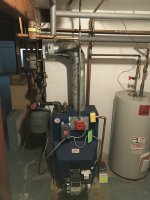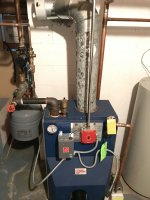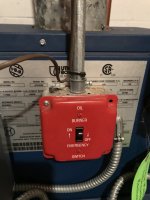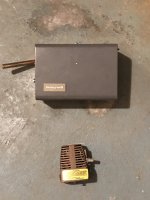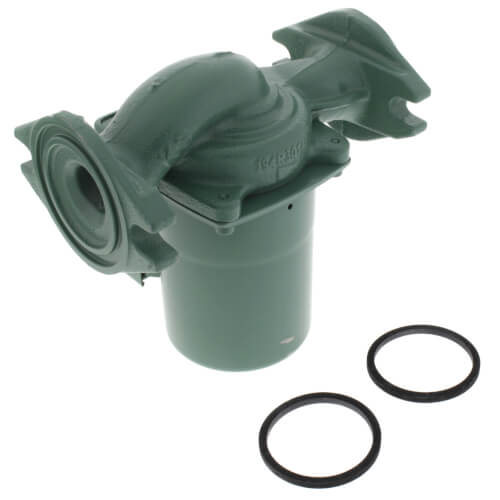In your first picture the gray iron block that has the expansion tank (the gray cylinder that looks a bit like a propane tank) hanging off it is an "air scoop". On top of it the bronze thingy with the li'l tire-valve type cap on top is a vent that lets air escape. You'll note there is also another vent directly on top of the boiler.
In the picture with the nameplate I can see the model number is a
Utica SFH3100W, with an input of 140,000 BTU/hr, and and 117,000 BTU/hr output.
The air-scoop needs at least a foot or so of straight pipe on it's input side to function well It's hard to tell from the angle of the picture how much pipe you have, but it doesn't look like much on either side. It looks to me like there's a ball valve (green handle, bronze body) just before the scoop, and a 90 degree ell just before the ball valve. The ell is introducing a lot of turbulence just as the water enters the air scoop, which keeps the bubbles from separating. It's probably still doing something, but it would do far better if it had a straight run on the intake side of the air scoop. There's usually an arrow on the side indicating the direction of flow:
Ideally the arrow on the air scoop (where the expansion tank is located) would be pointed in the direction of the pump and also be a straight pipe. Looking at
the manual it appears the direction is correct from expansion tank to pump, but there's a 90 degree ell introducing turbulence at the pump input. That will make it more prone to cavitation and noise. (What is that pump, a Taco 007, mayhaps?)
But verify the direction arrow cast into the air scoop body is pointing away from the boiler, and that the flow direction arrow cast into the pump body is pointing away from the air scoop/expansion tank. (You'd be amazed at the kind of stupid-attacks like that still work when the boiler is ridiculously oversized for the load.)
The gauge on the corner of the boiler indicates both temperature and pressure. What is the pressure reading at the end of a burn cycle? What is the pressure reading at the beginning of a burn cycle?
The last picture shows an aquastat (not a thermostat) and the top of a zone valve. I take it that the gray box to the left of the red burner power switch is what replaced it? Is there a model number on the new one? (Sometimes you have to remove the cover to see the model number.)
An output of 117,000 BTU/hr is enough heat to keep my 2400' 2x4 framed 1.5 story + 1600' of conditioned basement nice and cozy at an outdoor temperature of -130F (< no, that's not a typo), and probably yours too. If you are on a regular oil fill up service that stamps a "K-factor" on the billing slips, what was the most recent K-factor? It's possible to determine the design heat load of your house and optimal boiler size from wintertime K-factors, but not during the shoulder seasons or summer (due to errors introduced by the water heater zone, and higher solar gain from windows, etc.) If this thing is more than 1.7x oversized for the space heating load (which it almost certainly is), it may be worth investing in a smarter boiler control, if the new Honeywell isn't designed to purge heat from the boiler at the end of a call for heat from the room thermostats.
At an average water temperature of 170F (180F out of the boiler, 160F coming back) the Slantfin baseboards will deliver about 500BTU/hr per running foot of baseboard into the room. For the boiler to not cycle on/off during an extended call for heat by the zone thermostats (the ones on the wall that you can adjust the room temp with) it takes 117,000/500= 234 feet of baseboard. With less baseboard than that the boiler will cycle on & off between it's low-limit and high limit temperatures determined by the aquastat settings. The less baseboard you have, the more quickly the temperature will slew from the low-limit to the high limit. If that burn time is less than ten minutes the boiler won't hit it's AFUE efficiency numbers, and if it's less than 5 minutes it's going to be substantially less.
So it matters from a maintenance and efficiency point of view how much baseboard you have. Care to share that info?
The return pipe enters the boiler near the bottom at the back side, visible as bare copper that's parallel with the exhaust vent pipe in the picture. When both zones are calling for heat (turn both wall thermostats up by 5F), measure the return water temperature with a meat thermometer taped or wired to the that pipe tightly wrapped with an inch or more around the business end of the thermometer. (It can be a foot above the boiler if you like- no need for a contortion act between the boiler & water heater.) If the boiler is cycling (probably is), note the temperature difference between the boiler's gauge and y the end of a burn measure the temperature of the return water, and compare it to the temperature on the boiler's gauge. If it's only 5-10F you can definitely back off on the pumping rate, which will lower the overall turbulence in the system that is keeping the air from separating and self-purging quickly.
It looks like there are separate ball valves on each zone, located above the water heater, which would be a reasonable spot to start throttling back flow. Unlike gate valves, ball valves can be reasonably operated in a partially open position without excessive wear, and are often used for adjusting flows. When restricting flow, measure the return water temperature on the zone plumbing near the ball valve so that you know when it's being cut back too far. A difference of 15-25F lower than whatever the boiler temperature reading is would be about right when the boiler is at 150F or higher.
There are smart pumps that work as drop-in replacements that can be programmed to a particular flow, pressure, or even temperature difference (with wired sensors). Whether or not it's worth the hassle is your call, but it'll use about 1/10th the electricity of the existing pump, and will be almost guaranteed to be quieter, even when there is still air in the system. But slower flow/lower turbulence will also give the sub-optimally plumbed air scoop and the boiler vent a better shot at purging the residual air quickly.

